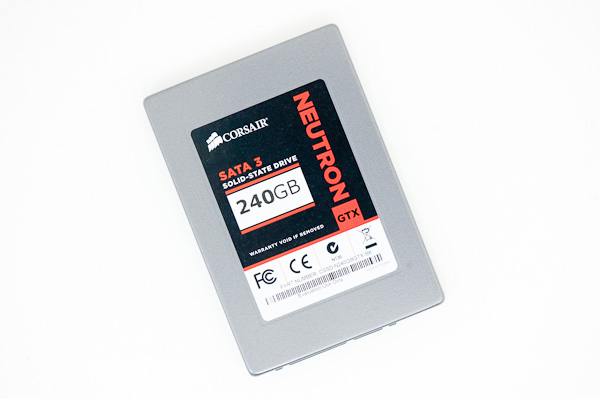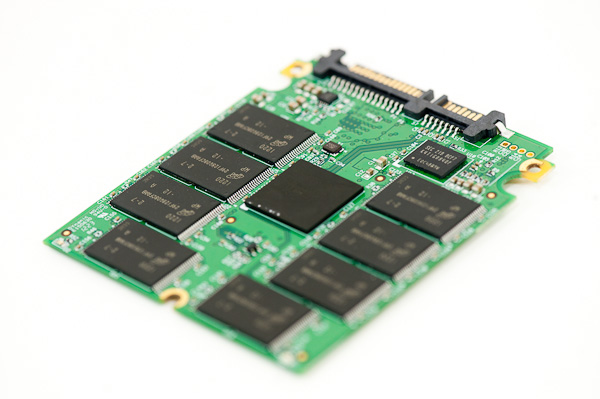Corsair Neutron GTX SSD Review (240GB): Link A Media Controller Tested
by Anand Lal Shimpi on August 20, 2012 6:00 AM EST- Posted in
- Storage
- SSDs
- Corsair
- Neutron
- Link a Media
These are worrying times if you're a traditional PC component vendor. The desktop PC market has been outgrown by notebooks for the past several years, and we're on the cusp of seeing mainstream mobile PCs embrace proprietary component form factors and abandon end user upgradability altogether. I do have faith (or at least hope?) that we'll find some solution to the conflicting desires of upgradability and extreme portability without simply embracing disposable computing, but until then the world is going to keep getting more difficult for those who solely make components that go into a desktop case.
The transition of choice for the past few years was to build SSDs. While still not completely future proof, SSD upgrades are applicable to both desktop and conventional notebooks. Due to an outright failure of the traditional HDD vendors to get in early with solid state storage, smaller SSD vendors had a chance.
OCZ was one of the first to make the transition from PC component vendor to SSD manufacturer. OCZ eventually fully embraced its new life, shedding almost all of its former product categories with the exception of power supplies.
Corsair on the other hand was much more cautious. Not interested in diving headfirst into a market full of teething pains, Corsair held off on its first SSD introduction. Even after it entered the market, Corsair remained conservative when it came to adopting new controllers. Corsair shipped Samsung when it wasn't attractive and was late to the party with both Indilinx and SandForce. Only its forays into the Marvell world were somewhat unique, but mostly because companies without firmware teams tended to stay away from Marvell.
Being conservative kept Corsair out of trouble for the most part (the SandForce issues unfortunately impacted everyone), but it also did nothing to establish the company as a serious player in the SSD space. Realizing there's no chance of winning if you play it too safe, Corsair announced a new SSD based on a new controller at Computex earlier this summer.
The drive is the Neutron, and the controller maker? Link A Media Devices, aka LAMD (Corsair is a bit better at marketing). At the time, Link A Media wasn't very well known in the enthusiast community although the acquisition announcement from SK Hynix a few weeks later helped to change that.
Link_A_Media Devices and The LM87800 Controller
Despite our unfamiliarity with the company, LAMD has been around building storage controllers for the past 8 years. The LM87800 (the heart of Corsair's Neutron) isn't its first SSD controller, but previous designs have been mostly focused on the enterprise with no major consumer wins. The company is probably better known for its HDD controllers that were used in consumer drives from Toshiba in the past. The experience in both building consumer storage controllers and SSD controllers clearly paid off in the maturity of the LM87800. As its first foray into the consumer space, the LM87800 looks less like an experiment and more like an entrenched competitor.
| SSD DRAM Size Comparison | |||||
| Drive | Controller | DRAM Size | DRAM Speed | ||
| Corsair Neutron GTX | LAMD LM87800 | 256MB | DDR2-800 | ||
| Crucial m4 | Marvell 88SS9174 | 256MB | DDR3-667 | ||
| Intel SSD 320 | Intel X25-M G3 | 64MB | SDR-166 | ||
| Intel SSD 520 | SandForce SF-2281 | 0MB | - | ||
| OCZ Vertex 4 | Indilinx Everest 2 | 512MB/1GB | DDR3-800 | ||
| Samsung SSD 830 | Samsung PM830 | 256MB | DDR2-800 | ||
The LM87800's spare area can be configured in firmware. Corsair opted to set aside ~13% of the total NAND as spare area for bad block replacement, wear leveling, recycling and general garbage collection. This gives the Neutron GTX the same capacity targets as most SandForce based drives (e.g. 120GB, 240GB, 480GB, 960GB). The relationship between NAND capacity, advertised capacity and what you see in your OS as usable space is in the table below:
| Corsair Neutron GTX Capacity | |||||
| Advertised Capacity | Total NAND | User Addressible Space | Spare Area | ||
| Corsair Neutron GTX 120GB | 128 GiB | 111.7 GiB | 12.7% | ||
| Corsair Neutron GTX 240GB | 256 GiB | 223.5 GiB | 12.7% | ||
| Corsair Neutron GTX 480GB | 512 GiB | 447.0 GiB | 12.7% | ||
The LM87800 doesn't employ any real time compression or data deduplication algorithms and thus behaves like a traditional SSD controller. There's no support for hardware based encryption. LAMD claims to integrate DSP-like functionality (a la Anobit?) to help increase endurance,
The controller supports eight NAND channels and a 6Gbps SATA interface, which are par for the course. There's not much else I know about the controller's architecture unfortunately. These companies tend to keep quiet about what they're doing internally as to avoid any potential patent challenges or give anyone a competitive advantage. Much of the secret sauce here is obviously in the firmware, the hardware is simply an enabler.













36 Comments
View All Comments
qwertymac93 - Monday, August 20, 2012 - link
Has more to do with SATA than NAND.SlyNine - Monday, August 20, 2012 - link
Thats Sata 3 limits. Not NAND flash.surt - Wednesday, August 22, 2012 - link
NAND can go faster. That's why products like the fusionio go to 2Gbps or higher. 500 is just the most you can get across a single sata3 connector.B3an - Monday, August 20, 2012 - link
When will the Plextor M5 Pro review be up?I've seen some other reviews popping up and it's looking very good, maybe the best SSD around, but these other reviews are not as detailed as Anandtech reviews.
Kristian Vättö - Monday, August 20, 2012 - link
Some odd behavior with the M5 Pro came up which has delayed the review a bit. I'll try to have it ready in the next few days, then posting it is up to Anand.B3an - Monday, August 20, 2012 - link
Thanks Kristian... and i hope you mention what this odd behaviour was in the review.Movieman420 - Monday, August 20, 2012 - link
Too soon for a review...a pre-view maybe Anand?M5P will do for now tho..;)
jwcalla - Monday, August 20, 2012 - link
At this point it seems that there is little, if any, real-world difference in the latest gen drives of similar NAND.seapeople - Monday, August 20, 2012 - link
Agreed. Crazy how everyone and his brother now has a blazing fast SSD out there that puts the x25-g2 to shame. Just three years ago we were happy when an SSD controller came out that didn't have stuttering issues.maximumGPU - Monday, August 20, 2012 - link
Agree with some of the previous comments, we need a comparison with the latest Plextor M5 pro.Btw Is the M5 pro the first to use Marvell's new controller, or is it the vertex 4?